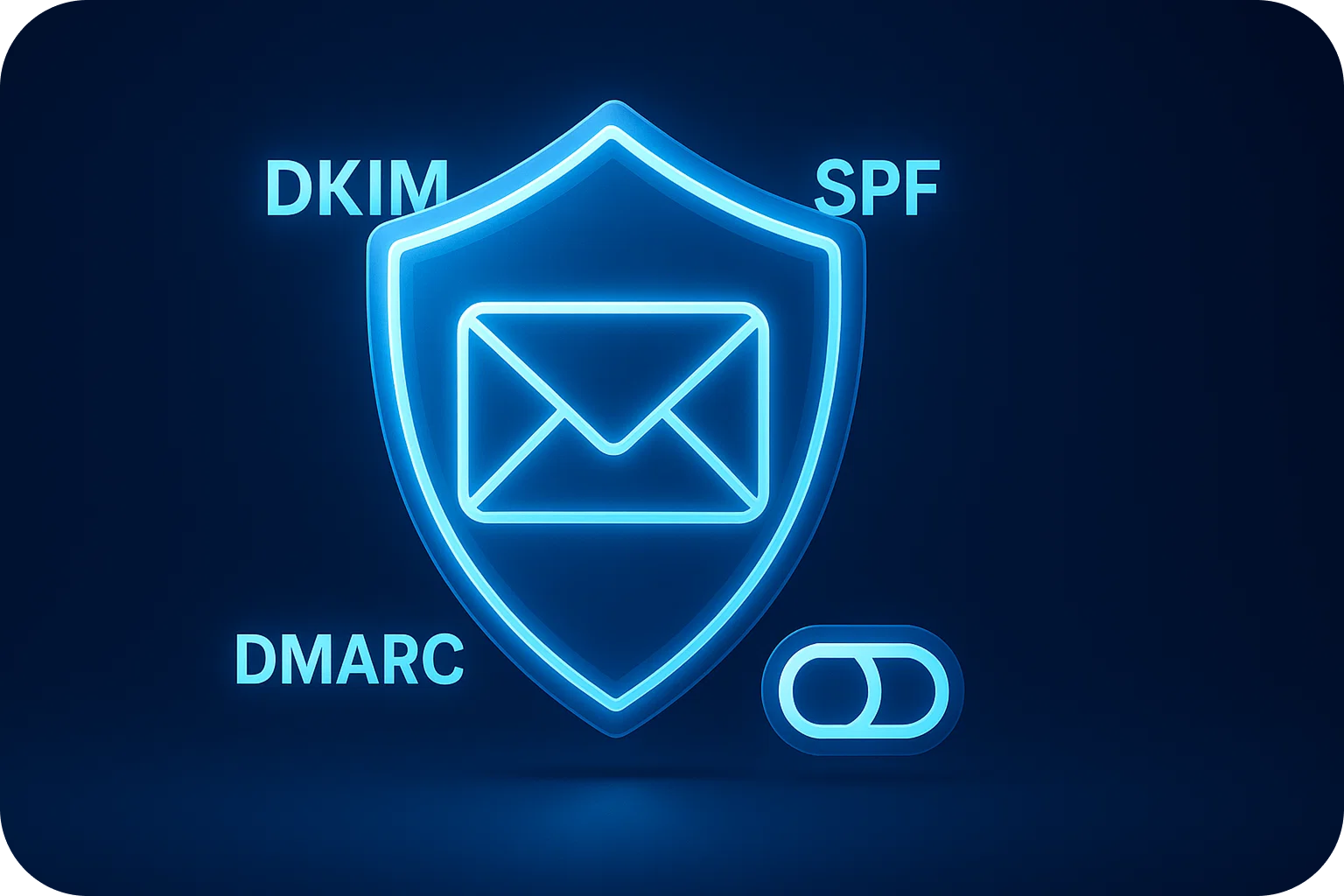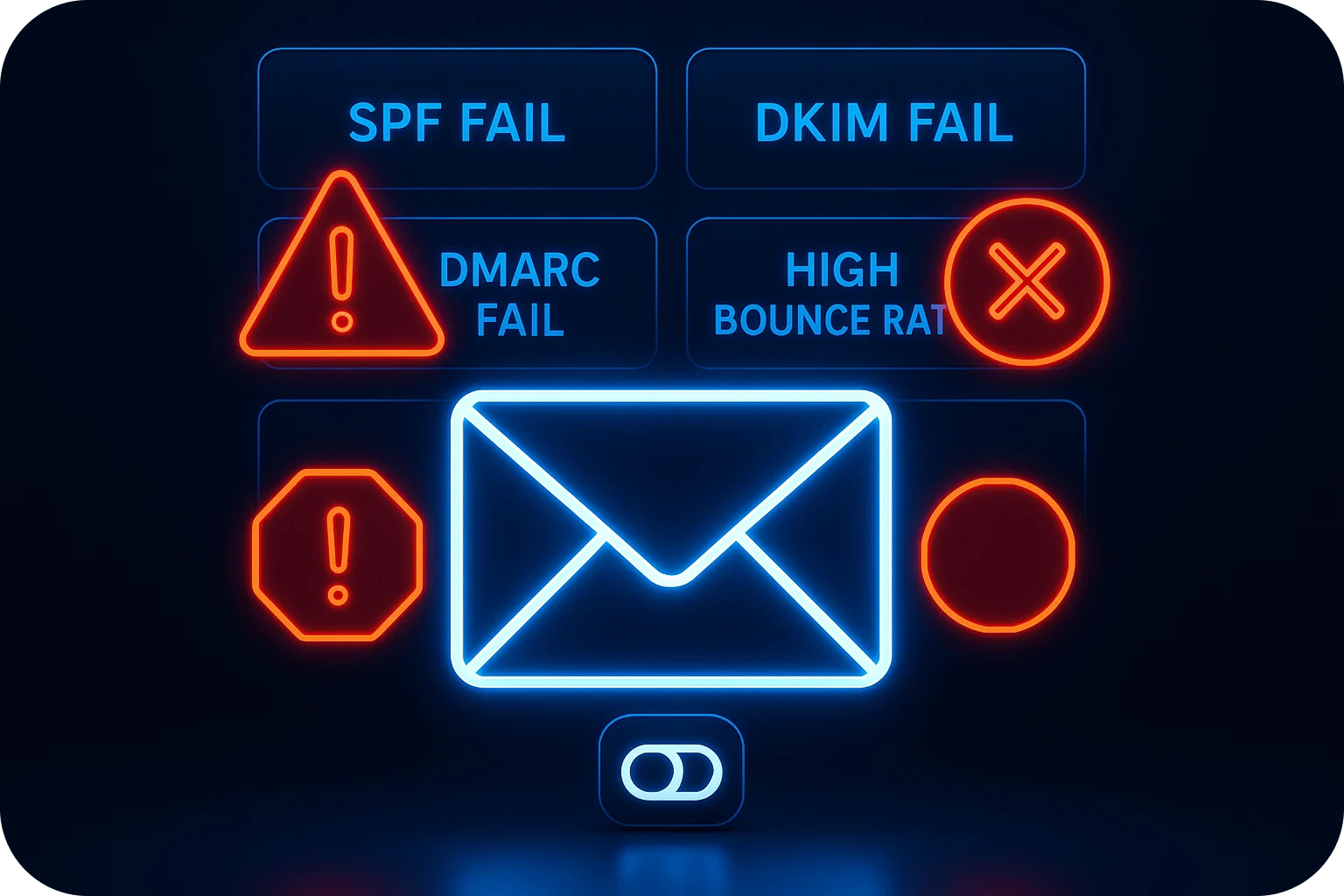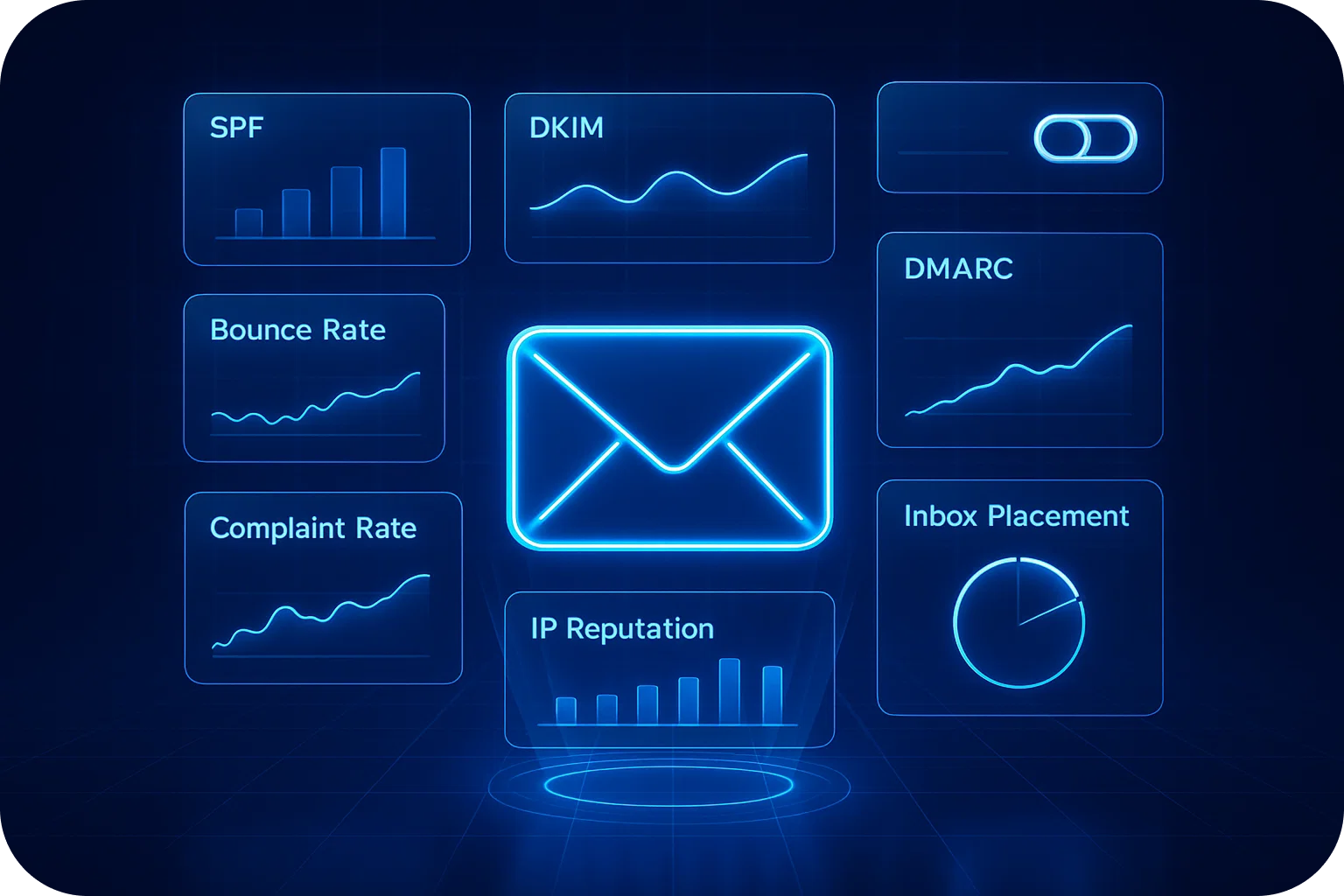Email Throttling Strategies: Managing Send Limits Across Multiple Providers
.png)
Scaling your cold email outreach isn't just about sending more emails; it's about sending them strategically. Email throttling and intelligent inbox rotation are the difference between landing in the primary inbox and triggering spam filters across every major provider.
If you're managing multiple email accounts across different providers, understanding how to balance send limits is critical for maintaining deliverability while maximizing your outreach volume. Let's dive into the strategies that help you scale cold email campaigns without compromising your sender reputation.
Understanding Email Throttling: The Foundation of Smart Sending
Email throttling is the practice of deliberately controlling the rate and volume at which you send emails. Think of it as pacing your outreach to match what email providers consider "natural" sending behavior.
Major email providers like Gmail and Outlook monitor sending patterns closely. When they detect sudden spikes in volume or unnatural sending patterns, they respond by:
- Filtering messages to spam folders
- Temporarily blocking your sending domain
- Permanently damaging your sender reputation
- Throttling delivery on their end, causing delays
The solution? Implement throttling strategies that distribute your email volume across multiple inboxes and providers while respecting each platform's unique limits.
Provider-Specific Send Limits: Know Your Boundaries
Different email providers enforce different sending limits, and understanding these boundaries is essential for effective throttling.
Google Workspace
Google Workspace accounts can technically send up to 2,000 emails per day, but for cold outreach purposes, the recommended maximum is significantly lower. Best practice suggests limiting sends to 20-50 emails per inbox per day to maintain optimal deliverability.
Microsoft 365 Outlook
Microsoft 365 accounts have similar technical limits but are often more sensitive to sudden volume changes. The same conservative approach applies: 20-50 emails per inbox daily for cold outreach campaigns.
Shared IP Mailboxes
Shared IP infrastructure requires even more careful throttling since multiple senders share the same reputation. Limit sends to 20-30 emails per inbox per day and monitor deliverability metrics closely.
Dedicated IP Solutions
Dedicated IPs offer more control and higher volume potential, but they require proper warm-up and consistent sending patterns. Once established, you can gradually scale to higher volumes while maintaining deliverability.
The Golden Rule: Maximum 100, Recommended 20
While you might technically be able to send 100 emails per inbox per day without immediate consequences, the recommended limit for maintaining 96-98% inbox placement rates is just 20 emails per inbox daily.
This conservative approach serves several purposes:
- Mimics human behavior: Real people don't send 100 cold emails from a single inbox every day
- Builds a gradual reputation: Consistent, moderate volume establishes trust with providers
- Provides safety margin: Leaves room for transactional emails and replies
- Reduces risk exposure: If one inbox encounters issues, your entire campaign isn't compromised
Inbox Rotation: Distributing Load Intelligently
Inbox rotation is the practice of distributing your email sends across multiple accounts to stay within provider limits while scaling your total outreach volume.
The 3-5 Inbox Per Domain Rule
Best practice recommends using 3-5 inboxes per domain, with a maximum of 5. This approach balances several factors:
- Maintains domain reputation by avoiding over-utilization
- Provides redundancy if one inbox encounters deliverability issues
- Allows for role-based email addresses that appear natural
- Enables A/B testing across different inbox configurations
If you need to send 100 emails daily, use 5 inboxes, sending 20 emails each, rather than one inbox sending 100. The total volume is identical, but the risk profile and deliverability outcomes are dramatically different.
Multi-Domain Strategies for Scale
When you need to scale beyond what 3-5 inboxes can handle, the solution is adding more domains, not more inboxes per domain.
For example, if you need to send 500 emails daily:
- Use 5 domains
- Deploy 5 inboxes per domain (25 total inboxes)
- Send 20 emails per inbox per day
- Total daily capacity: 500 emails with optimal deliverability
This approach allows you to scale cold email outreach 100x while maintaining the same per-inbox sending rate that ensures deliverability.
Implementing Time-Based Throttling
Beyond daily volume limits, the timing and distribution of your sends throughout the day significantly impact deliverability.
Avoid Burst Sending
Sending all your daily emails in a single burst, say, 20 emails at 9:00 AM, creates an unnatural pattern that providers may flag. Instead, distribute sends across business hours.
Optimal Distribution Patterns
Spread your 20 daily emails across 8-10 hours of business time. This creates a pattern that resembles a salesperson manually sending personalized emails throughout their workday:
- 9:00 AM - 2 emails
- 10:00 AM - 3 emails
- 11:30 AM - 2 emails
- 1:00 PM - 3 emails
- 2:30 PM - 4 emails
- 3:30 PM - 3 emails
- 4:30 PM - 3 emails
Timezone Considerations
If you're targeting recipients across multiple time zones, adjust your sending schedule to match their business hours. Receiving a cold email at 3:00 AM local time is an immediate red flag that screams "automated bulk sending."
Warm-Up Periods: The Foundation of Throttling Success
Even with perfect throttling strategies, new inboxes require a warm-up period before reaching full sending capacity.
The 3-4 Week Warm-Up Timeline
Plan for a 3-4 week warm-up period for new email accounts before implementing full-scale cold outreach. During this period:
- Week 1: Send 5-10 emails per day, primarily to engaged contacts
- Week 2: Increase to 10-15 emails per day, mixing warm and cold contacts
- Week 3: Scale to 15-20 emails per day with standard cold outreach
- Week 4: Reach full capacity of 20 emails per day
Warm-Up Best Practices
During the warm-up period, focus on generating positive engagement signals:
- Send to contacts likely to open and reply
- Ensure high-quality, personalized content
- Monitor deliverability metrics closely
- Adjust pacing if you notice deliverability drops
Monitoring and Adjusting Your Throttling Strategy
Email throttling isn't a set-it-and-forget-it strategy. Continuous monitoring and adjustment are essential for maintaining optimal deliverability.
Key Metrics to Track
Monitor these metrics across all your inboxes:
- Inbox placement rate: Aim for 96-98% across Gmail, Outlook, and Yahoo
- Open rates: Sudden drops may indicate deliverability issues
- Bounce rates: High bounce rates damage sender reputation quickly
- Spam complaint rates: Keep below 0.1% to maintain good standing
- Reply rates: Positive engagement signals improve deliverability
When to Adjust Throttling
Reduce sending volume immediately if you notice:
- Inbox placement rates are dropping below 90%
- Sudden increases in bounce rates
- Spam complaints from recipients
- Emails are taking longer than usual to deliver
Advanced Throttling: Provider-Specific Rotation
For maximum deliverability, consider implementing provider-specific rotation strategies that leverage the strengths of different email platforms.
Mixed Provider Approach
Rather than using a single provider for all your inboxes, distribute across multiple providers:
- 40% Google Workspace inboxes
- 40% Microsoft 365 Outlook inboxes
- 20% shared IP or dedicated IP solutions
This approach provides several benefits:
- Reduces risk if one provider changes policies
- Leverages different provider reputations
- Allows testing which provider performs best for your audience
- Provides redundancy for business continuity
Automation and Throttling: Finding the Balance
Modern cold email platforms offer sophisticated automation, but over-automation can undermine your throttling strategy.
Smart Automation Practices
- Randomize send intervals: Add 5-15 minute random delays between sends
- Vary email length: Don't send identical-length emails from the same inbox
- Personalize at scale: Use dynamic fields to ensure each email is unique
- Implement reply detection: Automatically pause sequences when prospects reply
Common Throttling Mistakes to Avoid
Even experienced teams make throttling errors that damage deliverability. Avoid these common pitfalls:
The "Just One More" Trap
Pushing limits by sending "just a few more" emails regularly adds up and damages reputation over time. Stick to your limits consistently.
Ignoring Weekend Patterns
Sending cold emails on weekends creates unnatural patterns. Most B2B professionals don't send cold outreach on Saturdays and Sundays.
Neglecting Reply Management
Continuing to send automated sequences after a prospect replies is a major red flag. Implement robust reply detection and sequence pausing.
Inconsistent Sending Patterns
Sending 100 emails one day and 5 the next creates suspicious patterns. Maintain consistent daily volumes.
The 10-Minute Implementation Advantage
The complexity of managing throttling across multiple providers, domains, and inboxes can be overwhelming. Modern cold email infrastructure platforms can reduce implementation time from weeks to minutes by:
- Automatically configuring optimal throttling settings
- Managing inbox rotation across providers
- Handling DNS configuration for all domains
- Implementing warm-up sequences automatically
- Monitoring deliverability across all inboxes
Scaling to 100x: The Ultimate Throttling Strategy
When you're ready to scale your cold email outreach dramatically, the throttling strategy remains the same; you simply multiply the infrastructure:
To send 2,000 emails daily while maintaining 98% deliverability:
- Deploy 20 domains
- Use 5 inboxes per domain (100 total inboxes)
- Send 20 emails per inbox per day
- Distribute sends across business hours
- Monitor deliverability metrics continuously
This approach allows you to scale cold email outreach 100x while maintaining the same per-inbox sending rate that ensures optimal deliverability.
Conclusion
Email throttling and inbox rotation aren't just technical requirements; they're competitive advantages. Teams that master these strategies achieve:
- 96-98% inbox placement rates across all major providers
- Sustainable scaling without deliverability degradation
- Protection against provider policy changes
- Consistent pipeline generation from cold outreach
The key is respecting provider limits, distributing volume intelligently, and maintaining consistent sending patterns that mimic human behavior. Start with the recommended 20 emails per inbox per day, use 3-5 inboxes per domain, and scale by adding domains rather than overloading existing infrastructure.
With proper throttling strategies in place, you can scale your cold email outreach to reach thousands of prospects daily while maintaining the deliverability rates that turn cold contacts into warm conversations and closed deals.
More articles
Get started now




%201.png)





